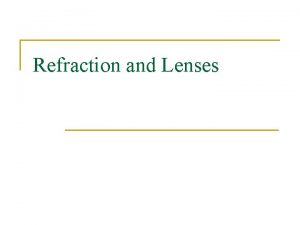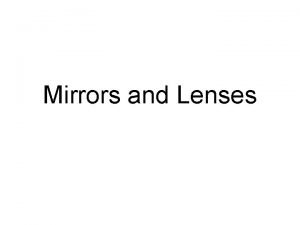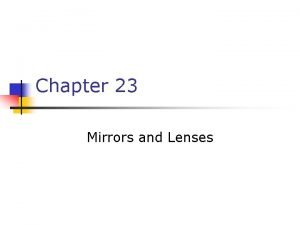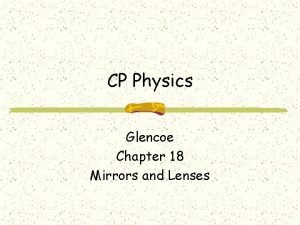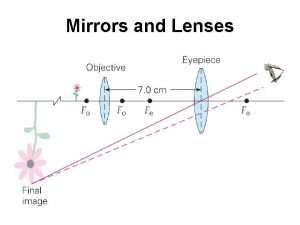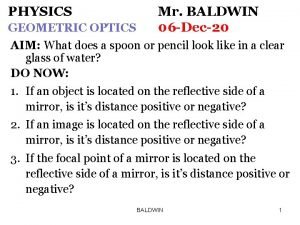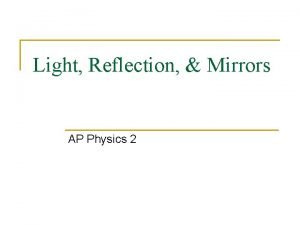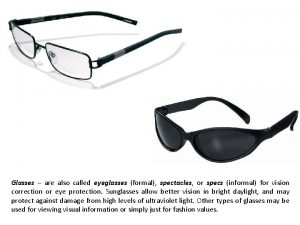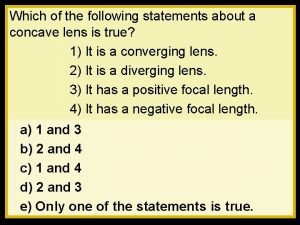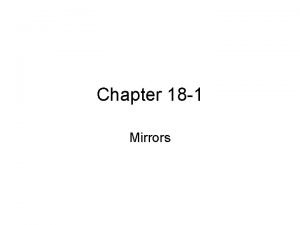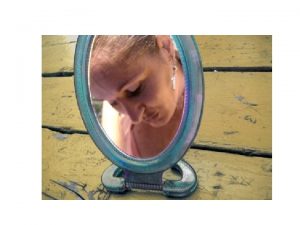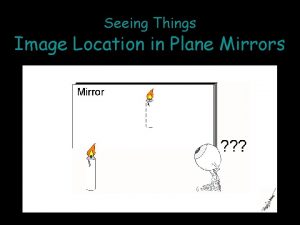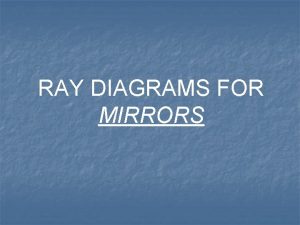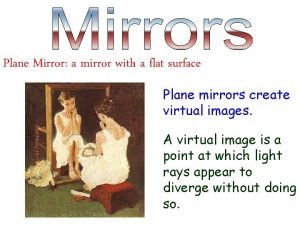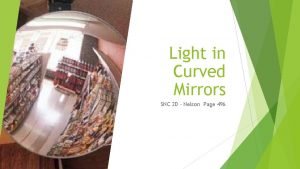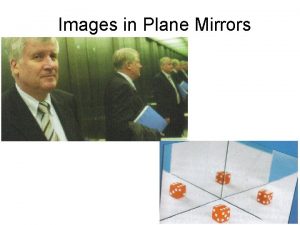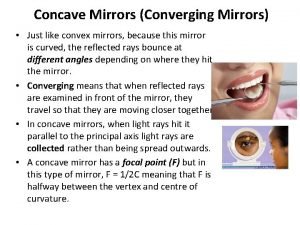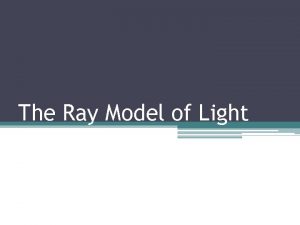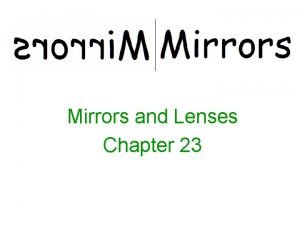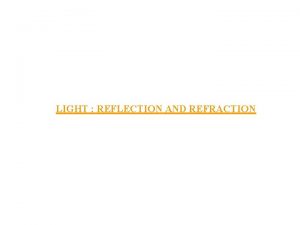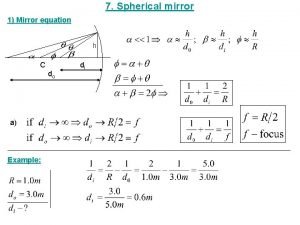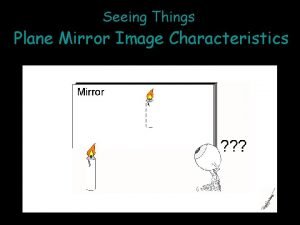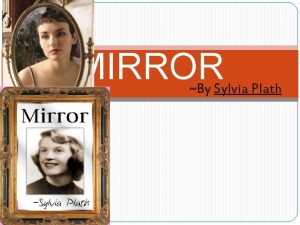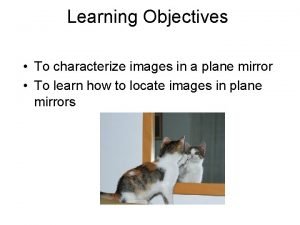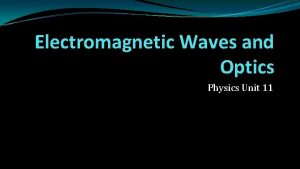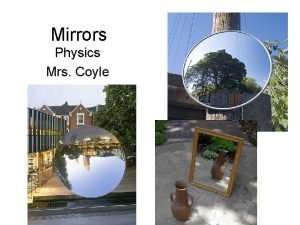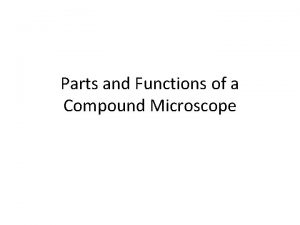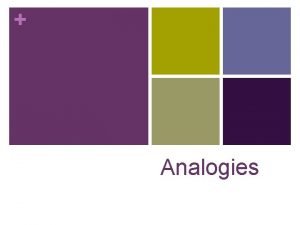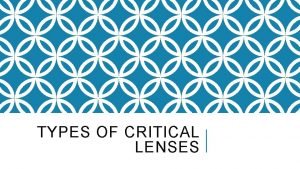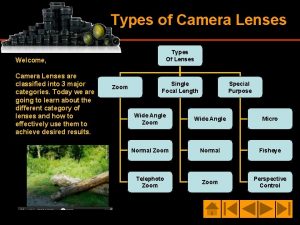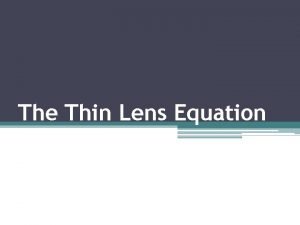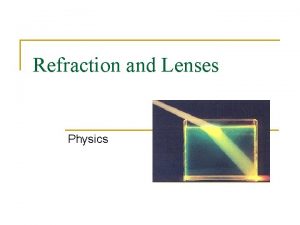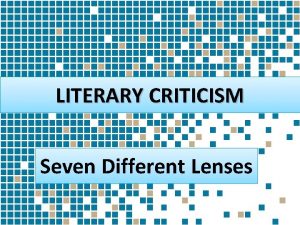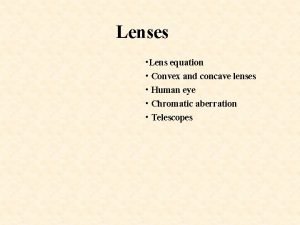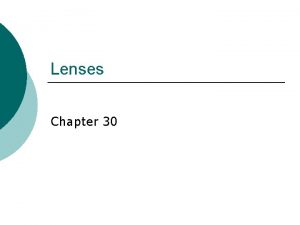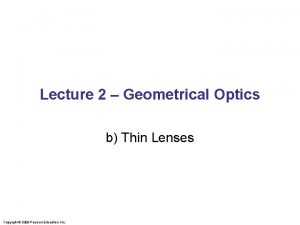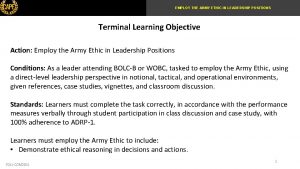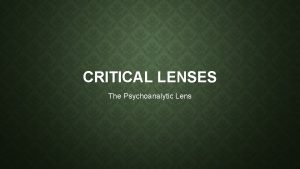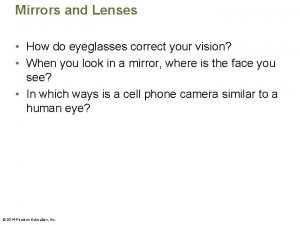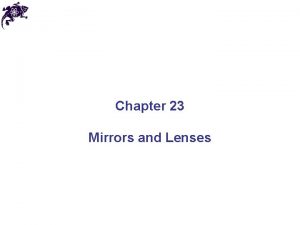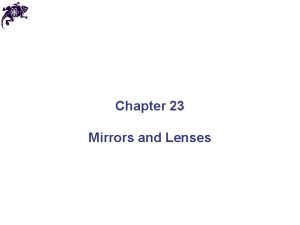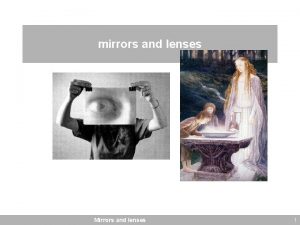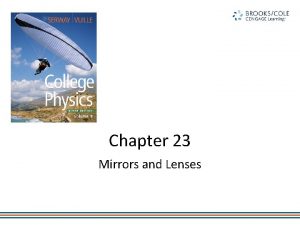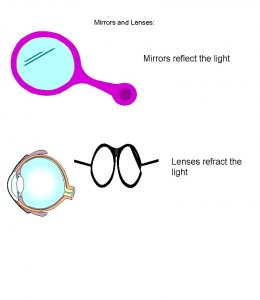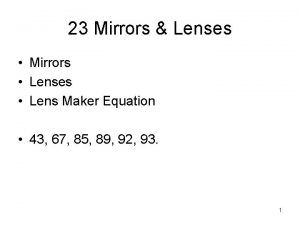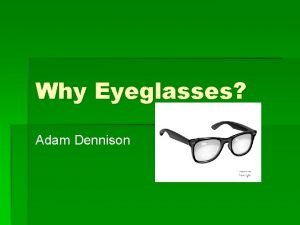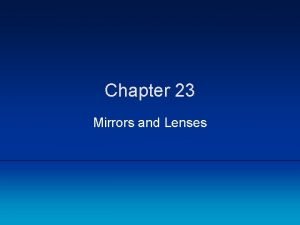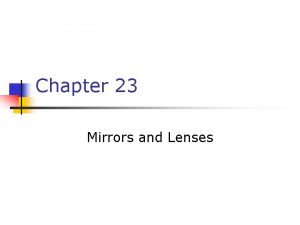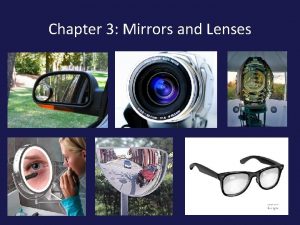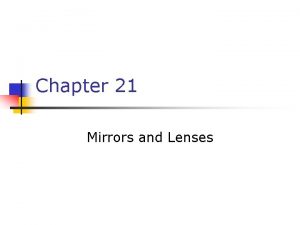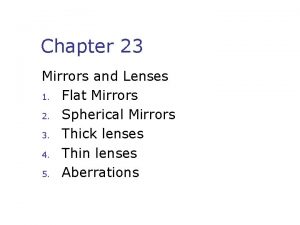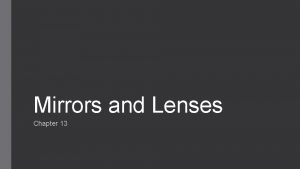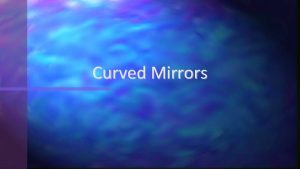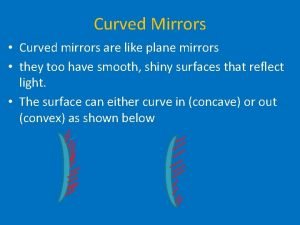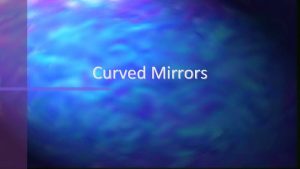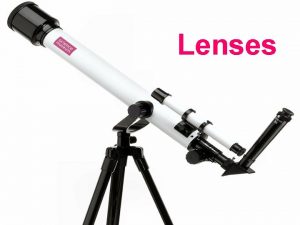Mirrors and Lenses How do eyeglasses correct your


























































- Slides: 58

Mirrors and Lenses • How do eyeglasses correct your vision? • When you look in a mirror, where is the face you see? • In which ways is a cell phone camera similar to a human eye? © 2014 Pearson Education, Inc.

Plane mirrors • The simplest mirror is a plane mirror—a flat, reflective surface, often consisting of a metal film covered in glass. © 2014 Pearson Education, Inc.

Seeing light from an object © 2014 Pearson Education, Inc.

Plane mirrors • The image of the real object seen in the mirror is located where light reflected from the mirror to the eye of the observer seems to originate. – This perceived image is behind the mirror and not on the surface of the mirror. • Using the ray diagram, we find that the image is exactly the same distance behind the plane mirror as the object is in front of it. © 2014 Pearson Education, Inc.

Plane mirror virtual image © 2014 Pearson Education, Inc.

Qualitative analysis of curved mirrors • A curved mirror is cut from a spherically shaped piece of glass backed by a metal film. © 2014 Pearson Education, Inc.

Concave mirrors • Concave mirrors are often used for magnification, in both telescopes and cosmetic mirrors. © 2014 Pearson Education, Inc.

Convex mirrors • Convex mirrors are used as passenger- side rearview mirrors and to provide visibility at blind spots, such as hallway corners and driveway exits. © 2014 Pearson Education, Inc.

Concave mirrors • Concave mirrors cause parallel incident rays to pass through a single point after reflection. – If the incident rays are also parallel to the principal axis, this point is called the focal point F of the mirror. © 2014 Pearson Education, Inc.

Tip © 2014 Pearson Education, Inc.

Focal point of a concave mirror • If a mirror has a large radius of curvature compared to its size and the incident rays are close to the principal axis, the focal point is approximately halfway between the center of the mirror and the center of curvature. © 2014 Pearson Education, Inc.

Reasoning Skill: Constructing a ray diagram to locate the image of an object produced by a concave mirror © 2014 Pearson Education, Inc.

Tip © 2014 Pearson Education, Inc.

Creating a virtual image with a concave mirror © 2014 Pearson Education, Inc.

Locating the image of the base of an object produced by a concave mirror • The image of the base of the object is always on the principal axis directly below the image of the top of the object. © 2014 Pearson Education, Inc.

Convex mirrors • With a convex mirror, rays parallel to the principal axis diverge after reflection from the virtual focal point F behind the mirror. © 2014 Pearson Education, Inc.

Reasoning Skill: Constructing a ray diagram to locate the image produced by a convex mirror © 2014 Pearson Education, Inc.

The mirror equation © 2014 Pearson Education, Inc.

Tip © 2014 Pearson Education, Inc.

Objects far away from the mirror • If an object is extremely far away along the principal axis, we can assume that rays from the object reaching the mirror are parallel to the principal axis. © 2014 Pearson Education, Inc.

Mirror equation © 2014 Pearson Education, Inc.

Magnification • The change in the size of the image compared to the size of the object is a quantity called linear magnification m: © 2014 Pearson Education, Inc.

Linear magnification © 2014 Pearson Education, Inc.

Tip © 2014 Pearson Education, Inc.

Qualitative analysis of lenses • A lens is a piece of glass or other transparent material with two curved surfaces that produces images of objects by changing the direction of light through refraction. © 2014 Pearson Education, Inc.

Convex lenses • A convex lens made of glass is similar to a concave mirror where incident rays parallel to the principal axis intersect at a focal point after passing through the lens. – How the rays converge depends on the curvature of the surface of the lens. © 2014 Pearson Education, Inc.

Tip © 2014 Pearson Education, Inc.

Convex lenses with water © 2014 Pearson Education, Inc.

Reasoning Skill: Constructing ray diagrams for single-lens situations: Convex lens © 2014 Pearson Education, Inc.

Reasoning Skill: Constructing ray diagrams for single-lens situations: Concave lens © 2014 Pearson Education, Inc.

Concave lenses • For concave lenses, light seems to diverge from a single point on the axis—the virtual focal point. © 2014 Pearson Education, Inc.

Ray diagrams for various lenses © 2014 Pearson Education, Inc.

Ray diagrams for various lenses © 2014 Pearson Education, Inc.

Image location of the base of the object • The image of the base of the object is directly beneath on the principal axis. © 2014 Pearson Education, Inc.

Thin lens equation and quantitative analysis of lenses • A thin lens has a radii of curvature much larger than the size of the lens. © 2014 Pearson Education, Inc.

Thin lenses © 2014 Pearson Education, Inc.

Tip © 2014 Pearson Education, Inc.

Seeing a sharp image on a screen • A screen must be placed where the image is located to view a sharp image. © 2014 Pearson Education, Inc.

Tip © 2014 Pearson Education, Inc.

Linear magnification in lenses • Lenses can produce images that are larger or smaller in size than the original objects. © 2014 Pearson Education, Inc.

Skills for analyzing processes involving mirrors and lenses • When problem solving: – Assume the lens/mirror is only slightly curved and the rays are incident near the principal axis. – Draw a ray diagram representing the situation in the problem. – Use the picture and ray diagram to help construct a mathematical description of the situation. © 2014 Pearson Education, Inc.

Photography and cameras • Light from an object enters the camera through the lens, which focuses the light on a surface that has light-sensitive properties (an image sensor). © 2014 Pearson Education, Inc.

Light field photography • In light field photography, the image sensor records all the light entering the camera, not just the light that would produce a sharp image on the focal plane. – A photographer can choose an object to focus on after the picture has been taken, because the camera effectively focuses on all objects at once. © 2014 Pearson Education, Inc.

Optics of the human eye • Light from an object enters the cornea and passes through a transparent lens. • An iris in front of the lens widens or narrows, like the aperture on a camera that regulates the amount of light entering the device. • The retina plays the role of the film. © 2014 Pearson Education, Inc.

Optics of the human eye • When the eye looks at distant objects, muscles around the lens of the eye relax, and the lens becomes less curved. • As the object moves closer, the eye muscles contract, increasing the curvature of the lens and reducing the focal length. © 2014 Pearson Education, Inc.

Corrective lenses • The two most common vision abnormalities corrected with lenses are myopia (nearsightedness) and hyperopia (farsightedness). © 2014 Pearson Education, Inc.

Corrective lenses (Cont'd) © 2014 Pearson Education, Inc.

Tip © 2014 Pearson Education, Inc.

Angular magnification and magnifying glasses • The impression of an object's size is quantified by its angular size: © 2014 Pearson Education, Inc.

Angular magnification • The angular magnification M of an optical system is defined as: © 2014 Pearson Education, Inc.

Angular size of the object as seen with the unaided eye • The maximum angular size of an object viewed by the unaided eye is: © 2014 Pearson Education, Inc.

Finding the image produced by multiple lenses © 2014 Pearson Education, Inc.

Telescopes • A common telescope has two convex lenses separated by a distance slightly less than the sum of their focal lengths. © 2014 Pearson Education, Inc.

The compound microscope © 2014 Pearson Education, Inc.

Summary © 2014 Pearson Education, Inc.

Summary © 2014 Pearson Education, Inc.

Summary © 2014 Pearson Education, Inc.

Summary © 2014 Pearson Education, Inc.
 Mirror and lens equation
Mirror and lens equation Mirrors and lenses
Mirrors and lenses Sign convention of mirror
Sign convention of mirror Physics classroom lenses and mirrors
Physics classroom lenses and mirrors Power of lens
Power of lens Mirror sign convention
Mirror sign convention Ap physics 2 mirrors and lenses
Ap physics 2 mirrors and lenses Glasses also called eyeglasses (formal)
Glasses also called eyeglasses (formal) Personal eyeglasses provide as much protection as
Personal eyeglasses provide as much protection as Which of the following statement about lenses is correct? *
Which of the following statement about lenses is correct? * Chapter 17 reflection and mirrors
Chapter 17 reflection and mirrors Spherical aberration in mirrors
Spherical aberration in mirrors Reflection and mirrors ppt
Reflection and mirrors ppt Give us your hungry your tired your poor
Give us your hungry your tired your poor Flat plate collector with adjustable mirrors
Flat plate collector with adjustable mirrors Seeing things in the mirror
Seeing things in the mirror Image formed by plane mirror
Image formed by plane mirror A mirror with a flat surface is a
A mirror with a flat surface is a Curved mirrors worksheet
Curved mirrors worksheet Salt mirror meaning
Salt mirror meaning Salt for concave mirrors
Salt for concave mirrors Name the two parts that make up most mirrors
Name the two parts that make up most mirrors Mirrors edge level design
Mirrors edge level design Concave mirrors can produce
Concave mirrors can produce Concave mirrors can produce
Concave mirrors can produce Single concave spherical mirrors produce images that
Single concave spherical mirrors produce images that Nd yag laser mirrors
Nd yag laser mirrors Synchronous adjustment mirrors
Synchronous adjustment mirrors Salt characteristics of a plane mirror
Salt characteristics of a plane mirror The new cartesian sign convention for spherical mirrors
The new cartesian sign convention for spherical mirrors Mirrors
Mirrors I am silver and exact poem
I am silver and exact poem All images in plane mirrors are apex
All images in plane mirrors are apex Physics 11-06 image formation by mirrors
Physics 11-06 image formation by mirrors Di/do physics
Di/do physics Function of draw tube in microscope
Function of draw tube in microscope Real self and ideal self by carl rogers
Real self and ideal self by carl rogers Do the following in your notebook
Do the following in your notebook In your notebook write questions and answer them
In your notebook write questions and answer them Chose the corect item
Chose the corect item Underline the correct
Underline the correct Underline the correct option
Underline the correct option In your notebook write question and answer
In your notebook write question and answer Write the correct words in your notebook
Write the correct words in your notebook In your notebook write two things that are
In your notebook write two things that are Literary lenses examples
Literary lenses examples Types of camera lenses
Types of camera lenses The lens equation
The lens equation Literary critical lenses
Literary critical lenses Physics of lenses
Physics of lenses Literary lenses
Literary lenses Purdue owl literary criticism
Purdue owl literary criticism Concave convex lens simulation
Concave convex lens simulation Chapter 30 lenses
Chapter 30 lenses Magnification equation lens
Magnification equation lens Biographical criticism ppt
Biographical criticism ppt Ethical reasoning model army
Ethical reasoning model army Psychoanalytic lenses
Psychoanalytic lenses Types of critical lens
Types of critical lens
